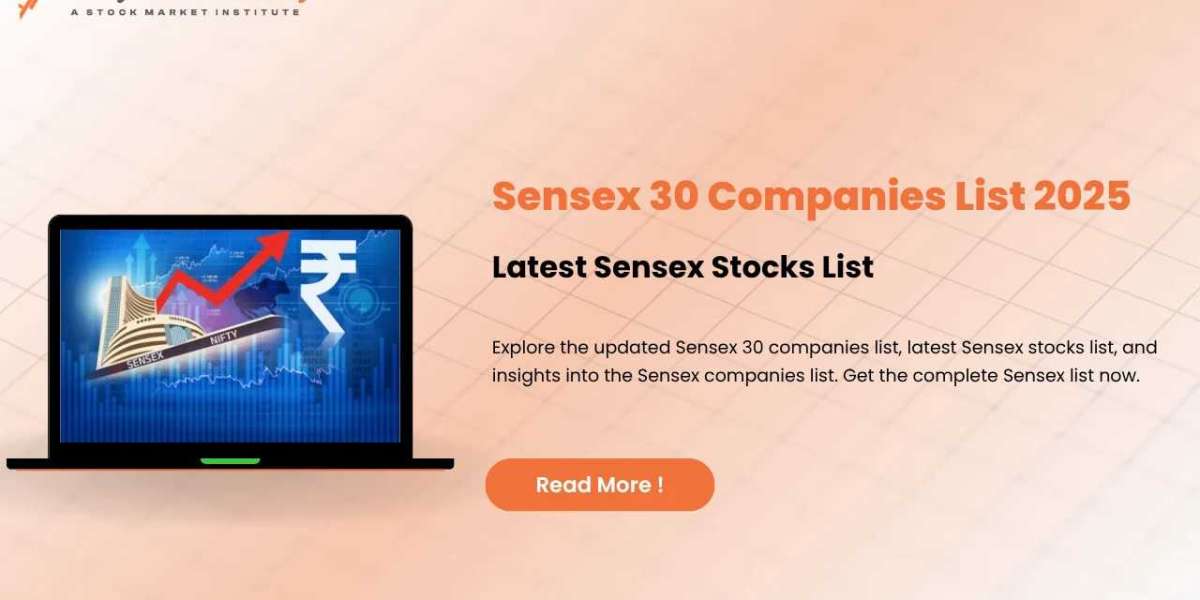Sensex 30 Companies List: A Complete Guide for Every Indian Investor
Introduction: What’s in the Sensex Basket?
Have you ever tried tracking the stock market and heard the term "Sensex" but weren't quite sure what it actually represents? You're not alone. For many, Sensex is just a scrolling ticker on TV or a topic reserved for financial gurus. But here's the truth—Sensex is the pulse of India’s stock market. And understanding the companies that make up this elite index can give you a head start in your investing journey.
Think of Sensex like the Indian Premier League (IPL) of the stock market. Just as IPL features the top-performing cricket teams, Sensex includes the top 30 companies that reflect the overall performance of the Indian economy.
If you’re looking to understand Sensex, explore the Sensex companies list, and maybe even take a stock market technical analysis course to sharpen your skills, this article is your one-stop guide.
Explore the Sensex companies list, top stock market technical analysis course, and best courses stock market India offers. A simple guide for all!
What is Sensex?
Sensex, short for the Sensitive Index, is the benchmark index of the Bombay Stock Exchange (BSE). It comprises 30 of the largest and most actively traded stocks from key sectors of the Indian economy. The Sensex was introduced in 1986 and is a barometer for India's economic performance.
Importance of Sensex in Indian Economy
The Sensex is more than just a number—it reflects investor sentiment and economic trends. When Sensex rises, it usually indicates optimism and growth; when it falls, people tighten their purse strings. Government policies, inflation, corporate earnings, and global markets all influence its movement.
How Are Sensex Companies Selected?
Sensex doesn’t randomly pick companies. The selection is based on strict criteria:
- Market capitalization
- Liquidity
- Revenue and profitability
- Sector representation
The goal is to ensure that the index accurately represents the performance of the Indian economy.
Complete Sensex 30 Companies List (2025)
Here’s the most updated Sensex companies list:
Company Name | Sector |
Reliance Industries Ltd | Energy |
Tata Consultancy Services | IT |
HDFC Bank | Banking |
ICICI Bank | Banking |
Infosys Ltd | IT |
Hindustan Unilever | FMCG |
ITC Ltd | FMCG |
Bharti Airtel | Telecom |
Larsen Toubro (LT) | Infrastructure |
Axis Bank | Banking |
Kotak Mahindra Bank | Banking |
State Bank of India | Banking |
Bajaj Finance | NBFC |
Asian Paints | Consumer Goods |
Maruti Suzuki | Auto |
Mahindra Mahindra | Auto |
UltraTech Cement | Cement |
Titan Company | Retail |
Sun Pharma | Pharma |
Power Grid Corporation | Power |
NTPC Ltd | Power |
Nestle India | FMCG |
HCL Technologies | IT |
Tech Mahindra | IT |
Wipro | IT |
IndusInd Bank | Banking |
Bajaj Finserv | NBFC |
Tata Motors | Auto |
JSW Steel | Metal |
Dr. Reddy’s Laboratories | Pharma |
Overview of Top 5 Sensex Companies
Let’s get to know the heavy hitters:
- Reliance Industries: A giant in energy, telecom (Jio), and retail. It’s like the Swiss Army knife of Indian businesses.
- TCS: India’s tech crown jewel. It’s among the world's top IT service providers.
- HDFC Bank: A powerhouse in personal and corporate banking.
- ICICI Bank: Known for aggressive innovation in financial services.
- Infosys: Trusted globally for software services and digital transformation.
Sector-Wise Breakdown of Sensex Companies
Here’s how different sectors are represented:
- Banking Finance: ~10 companies
- IT: 5 companies
- FMCG: 4 companies
- Auto: 3 companies
- Pharma: 2 companies
- Energy, Telecom, Cement, and Power: Remaining shares
This diversification helps the index remain stable and reliable.
Why You Should Know the Sensex Companies
If you’re even mildly interested in investing or pursuing a stock market technical analysis course, knowing the Sensex list gives you an edge.
Why?
- They're safe bets: These companies have proven track records.
- Market movers: Their performance directly affects the Sensex.
- Learning ground: They help beginners understand sectors and stock behavior.
Investment Strategies Using Sensex
Investors use various strategies:
- Index Investing: Buy a mutual fund or ETF that mirrors Sensex.
- Swing Trading: Use short-term price trends.
- Fundamental Analysis: Deep dive into financials of these 30 companies.
- Technical Analysis: Spot buy/sell signals using charts and indicators.
How to Track Sensex in Real-Time
You don’t need a Bloomberg terminal. Tracking Sensex is simple:
- Apps like Groww, Zerodha Kite, Moneycontrol
- TV channels like CNBC TV18, ET Now
- Official BSE website
- Google Search – Type “Sensex”
Real-time tracking helps in quick decision-making, especially if you're trading.
Role of Sensex in Technical Analysis
Technical analysis relies heavily on market trends, volumes, and price action. Since Sensex reflects the top 30 stocks, it helps:
- Identify overall market trends
- Spot breakouts and resistance zones
- Understand sector momentum
If you're taking a stock market technical analysis course, the Sensex is a core part of your learning.
Best Stock Market Technical Analysis Course in India
Looking to master charts and indicators?
Here are some top-rated options:
- NSE Academy Certified Courses
- Trendy Traders Academy – Offers real-time charting and pattern recognition.
- Elearnmarkets
- StockEdge Club
- FinGrad by Groww
These platforms cover price action, candlestick patterns, moving averages, and more.
Online vs Offline Courses in Stock Market India
Not sure which mode suits you? Let’s compare:
Online Courses:
- Flexible schedule
- Self-paced
- Cost-effective
Offline Courses:
- Direct mentor interaction
- Structured learning
- Networking opportunities
Choose based on your learning style and budget. Many courses in stock market India are hybrid too!
How Sensex Affects Retail Investors
The Sensex is a reflection of where money is flowing. Here’s how it impacts retail investors:
- Portfolio planning: Investors mimic the index to reduce risk.
- Sentiment indicator: A rising Sensex boosts investor confidence.
- Learning tool: It's a benchmark to compare personal investments.
Common Mistakes to Avoid While Investing in Sensex Stocks
Don’t blindly invest just because a company is in Sensex. Here are some pitfalls:
- Ignoring valuations
- Over-diversifying
- Short-term panic selling
- Neglecting technical/fundamental analysis
Always do your homework—even for blue-chip stocks.
Conclusion and Next Steps
Understanding the Sensex companies list is like learning the foundation of a house before building the rest. Whether you're a curious beginner or planning to enroll in a stock market technical analysis course, these 30 companies offer a solid starting point.
Your next step? Start following these companies, track their charts, read up on their sectors, and maybe join one of the top courses stock market India has to offer. The more you learn, the better you'll invest.
FAQs
What is the Sensex and why is it important?
Sensex is the benchmark index of the BSE, tracking 30 top Indian companies. It reflects the country's economic health and investor sentiment.
How often does the Sensex companies list change?
The list is reviewed semi-annually. Companies may be added or removed based on performance and eligibility criteria.
Can beginners invest in Sensex stocks?
Yes, Sensex stocks are ideal for beginners due to their stability, strong fundamentals, and large-cap status.
What’s the best way to start learning stock market technical analysis?
Enroll in a reputed stock market technical analysis course online or offline. Platforms like Trendy Traders Academy and NSE Academy are great for starters.
Are Sensex companies safe to invest in long-term?
Generally, yes. They are financially strong and well-governed. However, always research and diversify your investments.








